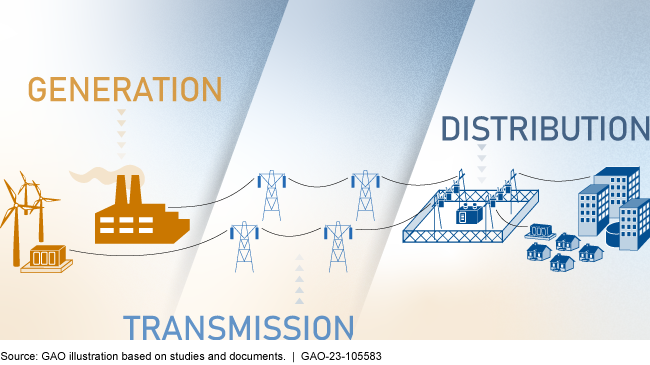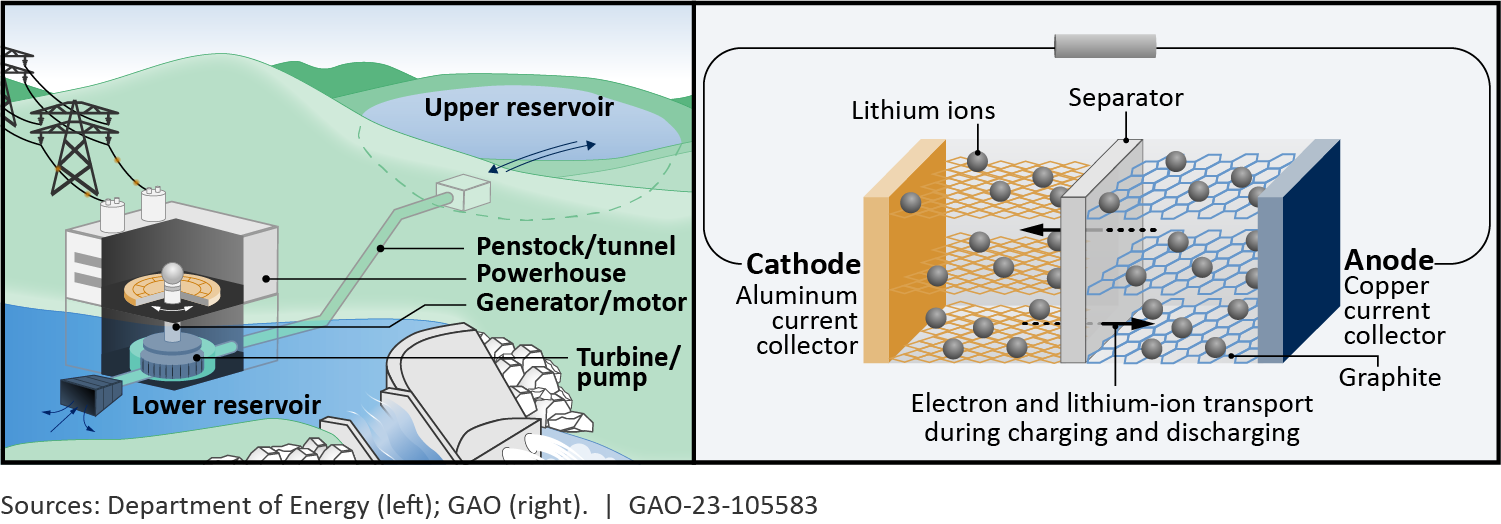Utility-Scale Energy Storage: Technologies and Challenges for an Evolving Grid
Fast Facts
The U.S. electricity grid was designed to generate electricity and deliver it almost immediately to customers—very little is stored.
Adding more energy storage could have benefits, like helping utilities
Meet demand during supply disruptions
Recover faster after outages
Support renewable energy by storing power when natural sources—like wind and sunlight—are abundant and releasing it when they are not
But it can be hard to put storage technologies on a grid that wasn't designed for this use. Also, putting storage on the grid means navigating varied state rules and regulations. We offer policy options to address these and other challenges.
Energy storage can be used at each stage of the process.

Highlights
What GAO Found
Technologies to store energy at the utility-scale could help improve grid reliability, reduce costs, and promote the increased adoption of variable renewable energy sources such as solar and wind. Energy storage technology use has increased along with solar and wind energy. Several storage technologies are in use on the U.S. grid, including pumped hydroelectric storage, batteries, compressed air, and flywheels (see figure). Pumped hydroelectric and compressed air energy storage can be used to store excess energy for applications requiring 10 or more hours of storage. Lithium-ion batteries and flywheels are used for shorter-duration applications such as keeping the grid stable by quickly absorbing or discharging electricity to match demand. Flow batteries represent a small fraction of total energy storage capacity and could be used for applications requiring 10 or more hours of storage. Metal-air batteries are being evaluated for applications requiring 10 or more hours of storage.
Pumped Hydroelectric (left) and Lithium-Ion Battery (right) Energy Storage Technologies

Energy storage technologies face multiple challenges, including:
- Planning. Planning is needed to integrate storage technologies with the existing grid. However, accurate projections of each technology’s costs and benefits could be difficult to quantify. Further, refinement of costs, benefits, and other data are needed to inform the planning process.
- Regulation. Rules and regulations vary across regions and states, which forces energy storage project developers to navigate a patchwork of potential markets. Developers that want to deploy storage across multiple markets may need to conduct separate analyses to determine each region’s regulatory outlook and profit potential.
- Standardization. Codes and standards may need revising and must keep pace with maturing technologies to minimize public safety and welfare risks. However, the technology’s evolution and deployment is outpacing codes and standards development. As a result, entities seeking to deploy new technologies may face challenges applying existing codes and standards to new technologies.
- Valuation. Realizing the potential of energy storage technologies may depend on the ability to value investments. For example, profit potential can vary because regions and states value storage differently, reflecting local market rules and regulations.
GAO developed six high-level policy options in response to these challenges. These policy options are provided to inform policymakers of potential actions to address the policy challenges identified in this technology assessment. They identify possible actions by policymakers, which include Congress, federal agencies, state and local governments, academic and research institutions, and industry. The status quo option illustrates a scenario in which policymakers do not intervene with ongoing efforts.
Policy Options to Address Challenges to Utility-Scale Energy Storage
| Policy options and implementation approaches | Opportunities | Considerations |
|---|---|---|
|
Status quo (report p. 48) Policymakers could maintain the status quo through:
|
|
|
|
Integration (report p. 50)
|
|
|
|
Regulation (report p. 52)
|
|
|
|
Standardization (report p. 54) Policymakers could update or create new codes and standards and provide education on storage safety risks. |
|
|
|
Support manufacturing and adoption (report p. 56) Policymakers could support actions to help energy storage manufacturing and adoption challenges by:
|
|
|
|
Provide Incentives (report p. 58) Policymakers could create mechanisms to incentivize storage deployment, by:
|
|
|
Source: GAO. | GAO-23-105583
Why GAO Did This Study
The U.S. electricity grid connects more than 11,000 power plants with around 158 million residential, commercial, and other consumers. Energy storage technologies have the potential to enable several improvements to the grid, such as reducing costs and improving reliability. They could also enable the growth of solar and wind energy generation.
GAO conducted a technology assessment on (1) technologies that could be used to capture energy for later use within the electricity grid, (2) challenges that could impact energy storage technologies and their use on the grid, and (3) policy options that could help address energy storage challenges.
To address these objectives, GAO reviewed agency documents and other literature; interviewed government, industry, academic, and power company representatives; conducted site visits; and convened a virtual meeting of experts in collaboration with the National Academies of Sciences, Engineering, and Medicine. GAO is identifying policy options in this report (see p. 2).
For more information, contact Brian Bothwell at (202) 512-6888 or bothwellb@gao.gov.
